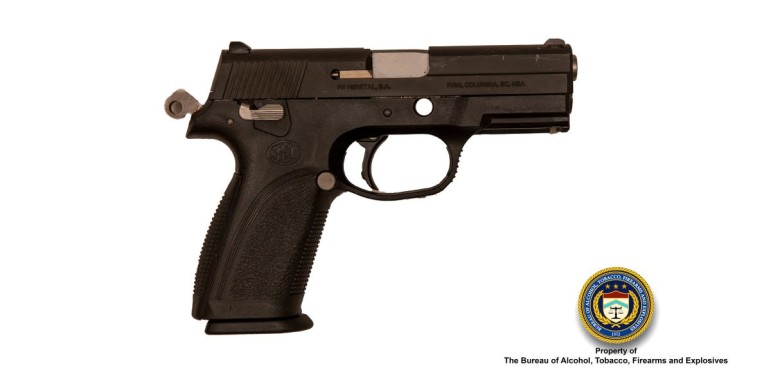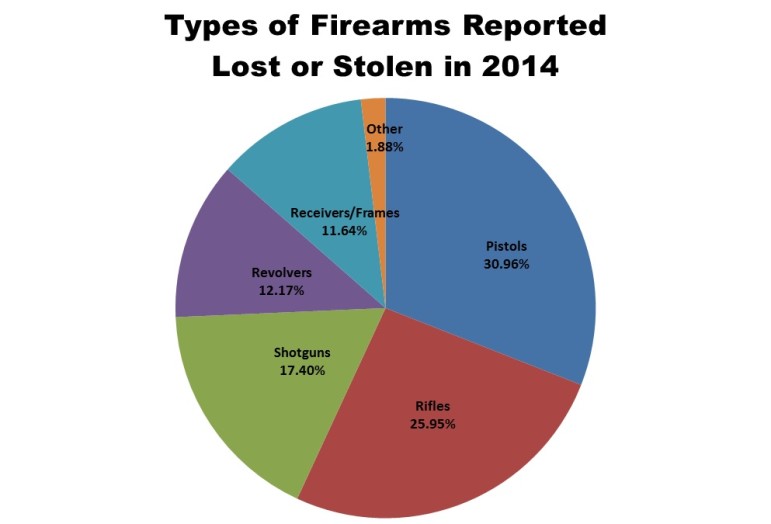
ATF
A Fabrique National 9mm. Nearly 6,000 pistols were reported lost or stolen last year.
President Obama’s call to ban people on the no-fly list from purchasing weapons has run into opposition not just from gun-rights supporters but also from other civil libertarians who have long worried about the lack of transparency or due process around the no-fly roster.
Even if those objections were overcome, banning any group of people—convicted criminals, the mentally ill or members of the no-fly list—will only prevent gun crimes if those would-be buyers cannot find a gun some other way. The “gun show loophole,” which exists in many states and permits people under some circumstances to make private sales of firearms without doing a background check, creates one avenue to gun ownership for people who might fail if screened.
Another is the alarming number of firearms that go missing each year, through loss or theft.
According to the Bureau of Alcohol, Tobacco, Firearms and Explosives, more than 19,000 firearms or firearm parts were reported lost or stolen in calendar 2014, up from about 17,000 in 2012.

City Limits chart based on ATF data
In a nation that adds more than 10 million guns to its stockpile each year, the ATF figures don’t indicate that most gun owners have a hard time hanging on to their weapons. But as recent mass shootings have made tragically clear, just one or two guns can cause tremendous suffering.
What’s more, the ATF statistic is an undercount: It totals up the reports of losses or thefts from Federal Firearms Licensees (FFLs). FFLs are people or companies who make or sell weapons, and they are required to report missing guns quickly to a centralized database. The number of weapons lost by private owners is certainly higher.
In 2012, ATF tried to estimate that figure and came up with 190,342. That was probably an undercount too. “Reporting by law enforcement is voluntary, not mandatory, and thus the statistics in this report likely reveal only a fraction of the problem,” ATF said. “Additionally, even where state and local law enforcement are consistently reporting statistics, many states do not require private citizens to report the loss or theft of a firearm to local law enforcement in the first place. As such, many lost and stolen firearms go entirely unreported. Moreover, even if a firearm is reported as lost or stolen, individuals often are unable to report the serial number to law enforcement because they are not required to record the serial number or maintain other records of the firearms they own for identification purposes. As a result, many lost and stolen firearms enter secondary and illicit markets with their status undocumented and undetectable.”
New Yorkers often (and rightly) look down their noses at the states whose lax gun laws facilitate the illegal trafficking of weapons to our city to be used in crimes. But as the table below indicates, FFLs in the Empire State lost track of an enormous number of weapons last year:
| State | Firearms reported loss of stolen by FFLs in 2014 |
| New York | 4017 |
| Texas | 2510 |
| Georgia | 914 |
| Wyoming | 851 |
| Connecticut | 715 |
| Indiana | 603 |
| Alabama | 582 |
| Florida | 569 |
| Colorado | 548 |
| North Carolina | 548 |
| Kentucky | 454 |
| South Carolina | 417 |
| California | 405 |
| Missouri | 386 |
| Mississippi | 379 |
| Pennsylvania | 372 |
| Arizona | 347 |
| Arkansas | 317 |
| Ohio | 313 |
| Tennessee | 295 |
| Massachusetts | 292 |
| Maryland | 231 |
| Kansas | 224 |
| Montana | 213 |
| Oklahoma | 211 |
| Louisiana | 207 |
| Washington | 199 |
| Illinois | 196 |
| Wisconsin | 190 |
| Minnesota | 187 |
| Virginia | 182 |
| New Hampshire | 151 |
| Idaho | 118 |
| Michigan | 114 |
| Iowa | 111 |
| Maine | 102 |
| Utah | 102 |
| Vermont | 93 |
| Alaska | 89 |
| West Virginia | 84 |
| North Dakota | 75 |
| Oregon | 74 |
| Nevada | 62 |
| New Mexico | 60 |
| South Dakota | 36 |
| Rhode Island | 27 |
| Hawaii | 21 |
| Delaware | 15 |
| Nebraska | 12 |
| New Jersey | 2 |
As the Times reported on Tuesday, “Most gun-control advocates, while supporting limits on high-powered rifles, place a higher priority on measures they say could tighten the availability of firearms to criminals, the mentally ill and other potentially dangerous people — above all, extending mandatory background checks to every gun transfer.” In part, that reflects a political reality: It’s a lot harder for the gun lobby to fight efforts to keep felons and the mentally ill from getting guns than it is for them to resist efforts to keep good and decent gun owners from possessing particular types of weapons. It is also true that gun manufacturers have proven adept at finding legal ways around gun bans that focus on prohibiting specific characteristics of weapons.
But while banning classes of weapons isn’t politically easy or technically foolproof, banning classes of people from owning weapons is no panacea, either. Beyond the due process concerns (especially when it comes to mental illness), the sheer number of guns in the United States challenges attempts to keep firearms out of particular hands.








One thought on “We Have the Right to Bear Arms … and Lose Thousands of Them”
Difference between #3(Georgia) and #1(NY) is honestly astounding: 4x times higher is pretty surprising to say the least. But it might be due to some states people just not reporting about a loss of firearm I guess.